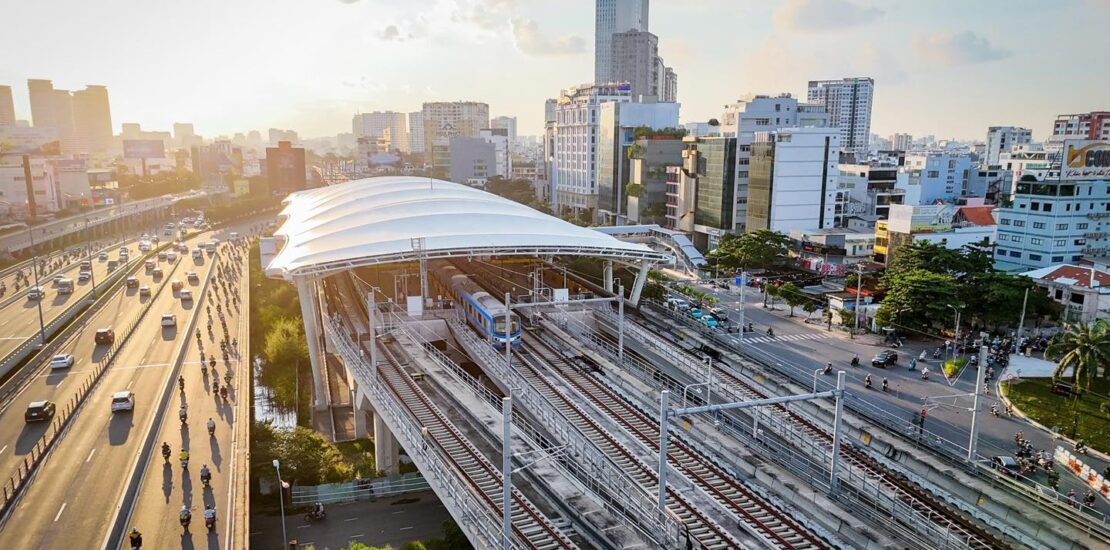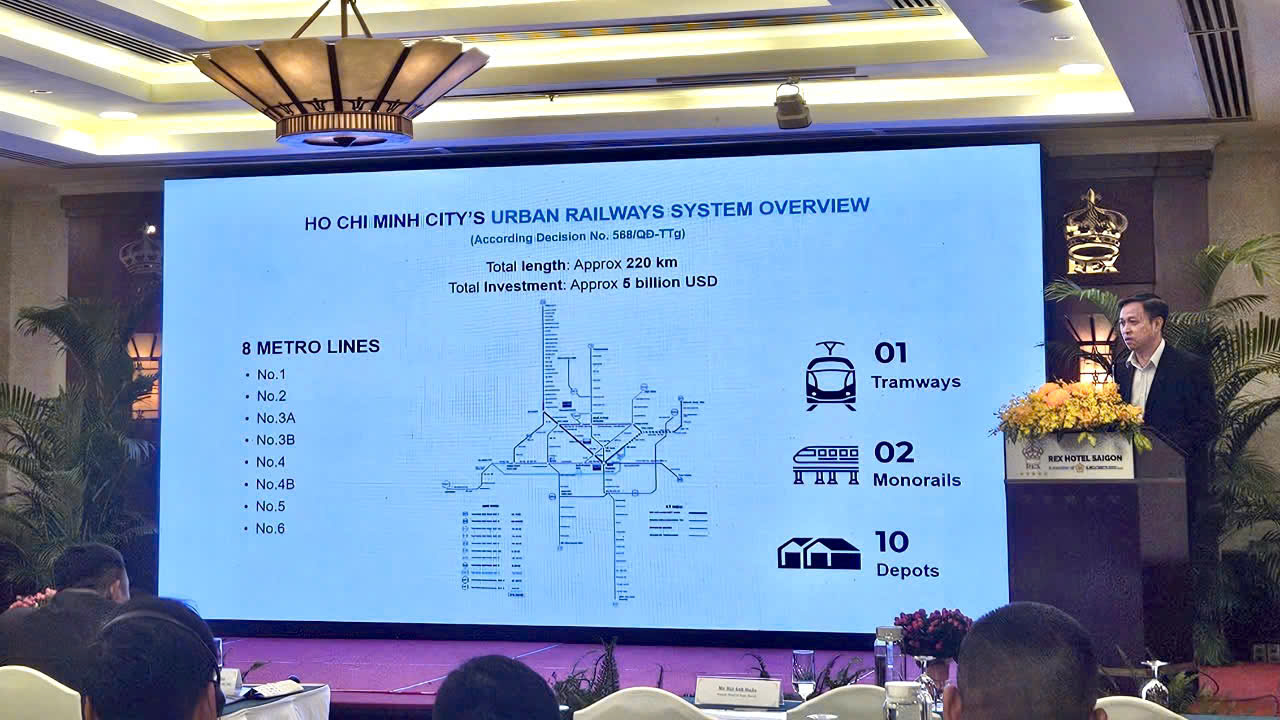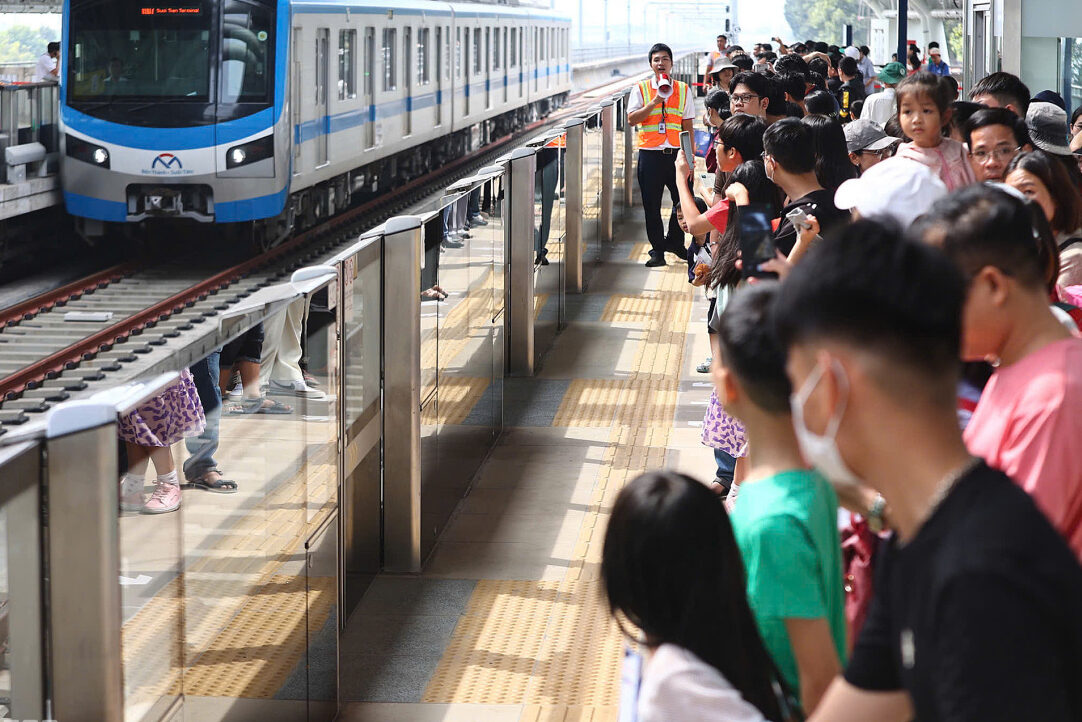Ho Chi Minh City’s new metro
- 23/12/2024
- Posted by: Thao Tran
- Category: News

Ho Chi Minh City, Vietnam’s largest and arguably its most dynamic metropolis, has witnessed rapid urbanization and significant population growth over the past few decades. As the city’s population swells (currently estimated at 10 million), so does the pressure on its transport infrastructure. Congestion on the roads has become a pressing issue, affecting productivity, the environment, and the quality of life for Ho Chi Minh City’s residents. In response to these challenges, the city embarked on the ambitious task of developing a modern metro system that should address the needs of its growing urban landscape.
The solution: a metro

Indeed, one of the most prominent solutions is the development of a metro system. Hanoi, the capital of Vietnam, already has two operating metro lines. And now Ho Chi Minh City is following suit. The newly inaugurated Metro Line 1, which connects the Eastern districts of the city with the downtown area, is the first step in what will eventually become a sprawling network of metro lines. This first metro line, with a total length of 19.7 kilometers and 14 stations, represents a major leap forward for the city’s transport system. The stations include a mix of elevated platforms and underground stops, designed to integrate with the existing urban infrastructure and minimize disruption to city life.
The first line: a step toward sustainable urban transport
Line 1’s mission
The opening of the first metro line is the culmination of a long journey that began in the early 2000s. Serious planning for the metro system began as far back as 2007, with official groundwork for construction starting in 2012. The line is designed to alleviate the massive traffic congestion that plagues the city’s roads, particularly during rush hours. With an estimated capacity of 930 passengers per train and a fleet of 17 trains initially, the city expects it to transport thousands of commuters each day, offering a faster, more comfortable alternative to buses and cars.
The very first steps
Line 1 will connect the densely populated District 1, which is the city’s central business district, to District 9 in the East, which is one of the city’s most rapidly developing areas. The line passes through major residential and commercial areas, facilitating access to key destinations and reducing the burden on the city’s busy road networks. By offering a reliable and efficient mode of transportation, the metro aims to cut down on travel time and reduce the environmental impact of road traffic.

In addition to its capacity to transport passengers quickly, the metro system will also help reduce traffic congestion in the city centre. The main arterial roads, such as those leading from the East into District 1, are often heavily congested, with long travel times and frequent gridlocks. With the metro, people will have an alternative way to travel without having to rely on cars, buses, or motorbikes, all of which contribute to air pollution and traffic jams.
The opening of Line 1 is also part of a broader effort to modernize Ho Chi Minh City’s urban infrastructure. As the city’s population grows and urban sprawl continues, a comprehensive public transport system becomes increasingly essential. The metro system not only offers a more sustainable mode of transport but also supports the city’s overall economic development, providing greater mobility for workers, students, and businesses.
Expansion plans: a vision for the future
While the opening of Line 1 is an important milestone, it is just the beginning of a much larger metro expansion project. The city’s long-term plan is to build a comprehensive metro network that covers all major districts and connects the city to surrounding urban areas. This ambitious vision aims to transform Ho Chi Minh City into a modern, world-class metropolis with a fully integrated and efficient public transportation system.
According to the city’s plans, by 2035, the metro system is expected to be largely completed, with multiple lines serving different areas of the city. There are currently several metro lines under development, each designed to address specific transportation needs in the city. For example, Line 2 will connect District 1 with the Southeastern suburbs, while Line 3 will link the city centre with the Western districts. These lines, along with others, will provide residents with more options for commuting and reduce dependence on private vehicles.
The ultimate goal is for the metro system to cover the entire city by 2060, linking all urban areas and providing seamless transportation options for residents. This comprehensive network will not only improve mobility within the city but also promote sustainable urban development, reduce pollution, and improve the quality of life for all citizens. People see the metro line as a key part of Ho Chi Minh City’s strategy to become a global city that is competitive, liveable, and environmentally friendly.

Challenges
Building a metro system in a rapidly growing city like Ho Chi Minh City is not without its challenges. One of the main obstacles is the high cost of construction and infrastructure development. The first metro line alone has required a substantial investment, and future lines will need significant funding as well. To overcome these financial challenges, the city is seeking a mix of public and private investments, as well as financial support from the government.
Another challenge is the coordination required between different levels of Government, as well as the integration of the metro system with other modes of transport, such as buses and taxis. Ensuring seamless connections between the metro and other public transport systems is crucial for the success of the network. Moreover, the city must also address urban planning and land use issues to ensure that the metro lines are well integrated into the fabric of the city.
Opportunities
Despite these challenges, the metro system presents tremendous opportunities for Ho Chi Minh City. It offers the potential to alleviate traffic congestion, reduce pollution, and improve the overall quality of life for residents. Furthermore, the metro system can stimulate economic growth, create jobs, and increase investment in urban development.

Conclusion: a modern transport system for the future
The opening of Ho Chi Minh City’s first metro line is a historic event that marks a new era in the city’s development. With the expansion of the metro network in the coming decades, the city will have a modern, efficient, and sustainable public transport system that can meet the needs of its growing population. The metro project reflects the city’s commitment to improving the lives of its residents and ensuring its place as a modern 21st century city.
VNHL is here to support you
VNHL follows the news in Vietnam closely. With our headquarters being located in Ho Chi Minh City, we are in a good position to support you with starting a business, doing business, investing, and/or living in Vietnam’s business capital. You can reach out to us via the chat button on the right of this page, or via our contact us page for further information and questions. Our three main services are: (i) consulting, (ii) networking, and (iii) supporting. We look forward to hearing from you and to supporting you.

*Dear reader, even though our VNHL Consulting team always tries its very best to provide its Clients with correct and complete info: we are not a Vietnamese law firm. The information in this post is therefore not meant to, and should also not be construed to, constitute legal advice. For specialized advice in the fields of law, accounting, tax, etcetera: we always recommend our Clients to speak with qualified specialists in those fields. We have several such specialists in our nationwide network, and we are always happy to introduce our Clients to them, when appreciated.


[…] IT / AI business. But sectors such as manufacturing, food and beverage, hospitality, education, and infrastructure are also popular for foreign investment in Vietnam. No matter the sector, however, setting up a […]